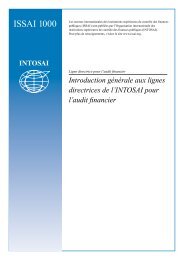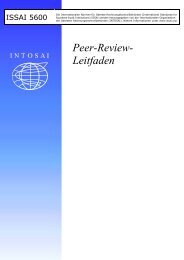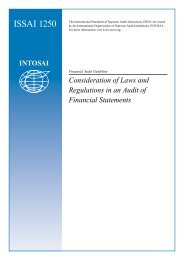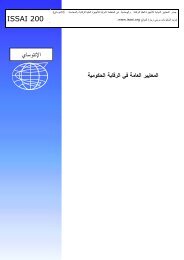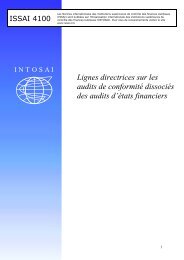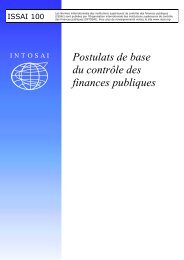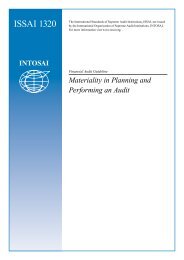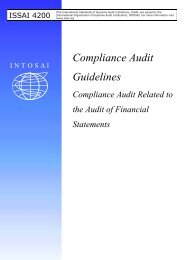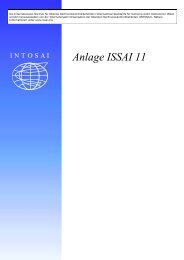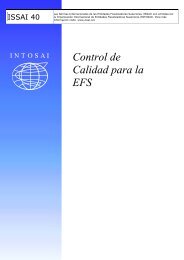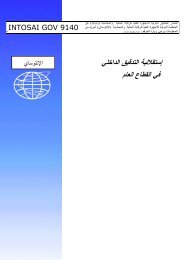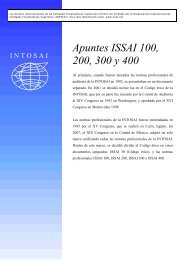ISSAI 100 â Fundamental Principles of Public Sector Auditing
ISSAI 100 â Fundamental Principles of Public Sector Auditing
ISSAI 100 â Fundamental Principles of Public Sector Auditing
You also want an ePaper? Increase the reach of your titles
YUMPU automatically turns print PDFs into web optimized ePapers that Google loves.
<strong>ISSAI</strong> <strong>100</strong>The International Standards <strong>of</strong> Supreme Audit Institutions, <strong>ISSAI</strong>, are issued by theInternational Organization <strong>of</strong> Supreme Audit Institutions, INTOSAI. For more information visitwww.issai.orgI N T O S A I<strong>Fundamental</strong> <strong>Principles</strong> <strong>of</strong><strong>Public</strong> <strong>Sector</strong> <strong>Auditing</strong>Exposure draftComments due 15 February 2013
Exposure INTOSAI draft <strong>ISSAI</strong> Pr<strong>of</strong>essional <strong>100</strong> – <strong>Fundamental</strong> Standards <strong>Principles</strong> <strong>of</strong> <strong>Public</strong> Committee <strong>Sector</strong> <strong>Auditing</strong>PSC-SecretariatRigsrevisionen • Store Kongensgade 45 • P.O. Box 9009 • 1022 Copenhagen K • DenmarkTel.:+45 3392 8400 • Fax:+45 3311 0415 •E-mail: info@rigsrevisionen.dkI N T O S A IEXPERIENTIA MUTUAEXPERIENTIA MUTUAOMNIBUS PRODESTOMNIBUSPRODESTINTOSAI General Secretariat - RECHNUNGSHOF(Austrian Court <strong>of</strong> Audit)DAMPFSCHIFFSTRASSE 2A-1033 VIENNAAUSTRIATel.: ++43 (1) 711 71 • Fax: ++43 (1) 718 09 69E-MAIL: intosai@rechnungsh<strong>of</strong>.gv.at;WORLD WIDE WEB: http://www.intosai.org2
Exposure draft <strong>ISSAI</strong> <strong>100</strong> – <strong>Fundamental</strong> <strong>Principles</strong> <strong>of</strong> <strong>Public</strong> <strong>Sector</strong> <strong>Auditing</strong>Table <strong>of</strong> contentINTRODUCTION 4PURPOSE AND AUTHORITY OF THE <strong>ISSAI</strong>s 4FRAMEWORK FOR PUBLIC SECTOR AUDITING 6Mandate 6Accountability, transparency, governance and performance 7Organisational requirements relating to quality control and ethics 8Objective <strong>of</strong> public sector auditing 9Confidence and assurance in public sector auditing 9Types <strong>of</strong> public sector auditing 10ELEMENTS OF PUBLIC SECTOR AUDITING 11The practitioner/auditor 11Responsible party 11Intended users 11Underlying subject matter 11Suitable criteria 12PRINCIPLES TO BE APPLIED IN CONDUCTING AN AUDIT 12General principles 13Ethics and independence 13Quality control 14Engagement team management and skills 14Audit/engagement risk 15Materiality 15Pr<strong>of</strong>essional scepticism and judgement 15Documentation 16Communication with auditees and other stakeholders 16<strong>Principles</strong> related to the audit process 16Activities related to planning the audit 16Activities related to performing the audit 17Activities related to evaluating audit evidence, concluding and reporting 18MAKING REFERENCE TO THE <strong>ISSAI</strong>s 19Authority <strong>of</strong> the <strong>Fundamental</strong> <strong>Auditing</strong> <strong>Principles</strong> 193
Exposure draft <strong>ISSAI</strong> <strong>100</strong> – <strong>Fundamental</strong> <strong>Principles</strong> <strong>of</strong> <strong>Public</strong> <strong>Sector</strong> <strong>Auditing</strong>INTRODUCTION1. Pr<strong>of</strong>essional standards and guidelines are essential for the credibility, quality andpr<strong>of</strong>essionalism <strong>of</strong> public sector auditing. The International Standards <strong>of</strong> Supreme AuditInstitutions (<strong>ISSAI</strong>s) developed by the International Organisation <strong>of</strong> Supreme Audit Institutions(INTOSAI) aim to promote independent and effective auditing and support the members <strong>of</strong>INTOSAI in the development <strong>of</strong> their own pr<strong>of</strong>essional approach in accordance with theirnational laws and regulations and mandate.2. <strong>ISSAI</strong> <strong>100</strong> provides the fundamental principles which are applicable to all public sector auditengagements whatever its form or context. In this context <strong>ISSAI</strong> <strong>100</strong> details information on thefollowing:the purpose and authority <strong>of</strong> the <strong>ISSAI</strong>sthe framework for public sector auditing, with reference to the Supreme Audit Institution’s(SAI) mandate and accountabilitythe organisational requirements relating to quality control and ethicsthe objectives <strong>of</strong> public sector audits, and confidence and assurance in public sectorauditingthe types <strong>of</strong> public sector auditing: financial, performance, and compliance auditingthe elements <strong>of</strong> public sector auditing including the roles <strong>of</strong> the auditor, responsible partyand intended users, as well as the underlying subject matter <strong>of</strong> the audit and suitablecriteriathe principles to be applied in public sector auditinghow to make reference to the <strong>ISSAI</strong>s.3. The <strong>ISSAI</strong> 200, 300 and 400 further elaborate on the principles to be applied in the context <strong>of</strong>financial auditing, performance auditing and compliance auditing. The principles contained inthese documents should be applied in conjunction with the principles presented in <strong>ISSAI</strong> <strong>100</strong>.PURPOSE AND AUTHORITY OF THE <strong>ISSAI</strong>s4. The <strong>ISSAI</strong> framework has four levels. Level 1 contains the founding principles for a SAI. Level2 sets out the prerequisites for the proper functioning and pr<strong>of</strong>essional conduct <strong>of</strong> a SAI,providing principles and guidance on independence, transparency and accountability, ethicsand quality control.5. Levels 3 and 4 provide principles and guidance relevant to conducting an audit rather than tothe SAI at the organisational level. They contain the common pronouncements by INTOSAI’smembers <strong>of</strong> the generally recognised pr<strong>of</strong>essional principles that underpin effective,independent auditing <strong>of</strong> public sector entities. The <strong>Fundamental</strong> <strong>Auditing</strong> <strong>Principles</strong> at level 3draw and elaborate on <strong>ISSAI</strong> 1 The Lima Declaration and the <strong>ISSAI</strong>s at level 2 and provide theauthoritative international frame <strong>of</strong> reference that defines public sector auditing in itscontemporary forms.4
Exposure draft <strong>ISSAI</strong> <strong>100</strong> – <strong>Fundamental</strong> <strong>Principles</strong> <strong>of</strong> <strong>Public</strong> <strong>Sector</strong> <strong>Auditing</strong>6. Level 4 translates the <strong>Fundamental</strong> <strong>Auditing</strong> <strong>Principles</strong> into more specific, detailed andoperational guidelines that can be used on a daily basis in the conduct <strong>of</strong> auditing tasks andcan be used as the auditing standards when national auditing standards have not beendeveloped. The General <strong>Auditing</strong> Guidelines (<strong>ISSAI</strong>s <strong>100</strong>0-4999) contain the recommendedrequirements for financial, performance and compliance auditing while the Guidelines onspecific subjects (<strong>ISSAI</strong>s 5000-5999) provide supplementary guidance on the auditing <strong>of</strong>specific subject matters or other important issues which may require the special attention <strong>of</strong>SAIs.Figure 1: International Standards <strong>of</strong> Supreme Audit Institutions5
Exposure draft <strong>ISSAI</strong> <strong>100</strong> – <strong>Fundamental</strong> <strong>Principles</strong> <strong>of</strong> <strong>Public</strong> <strong>Sector</strong> <strong>Auditing</strong>7. A prerequisite for the proper functioning and pr<strong>of</strong>essional conduct <strong>of</strong> SAIs is the public sectorauditor’s obligation to apply generally accepted auditing standards. The <strong>ISSAI</strong>s <strong>100</strong>, 200, 300and 400 contain the fundamental auditing principles for audit work conducted by the SAI. Theyprovide the foundation for the development <strong>of</strong> national standards or for the application <strong>of</strong> theguidelines on level 4.8. Reference to the <strong>Fundamental</strong> <strong>Auditing</strong> <strong>Principles</strong> in audit reports or Auditor’s Reports shouldonly be made if the standards applied fully comply with all relevant principles therein. Theprinciples do not override national laws, regulations or mandates.9. As public sector business and governance becomes more complex new requirements arebeing added through a combination <strong>of</strong> laws, regulations, standards, codes, and other guidanceand requirements. The architecture necessary to support these changing information needs isstill developing, however the common concepts and fundamental principles <strong>of</strong> public sectorauditing should still be applied.FRAMEWORK FOR PUBLIC SECTOR AUDITINGMandate10. A SAI exercises its public sector audit function within a specific constitutional arrangement andby virtue <strong>of</strong> its <strong>of</strong>fice and mandate which ensures sufficient independence and powers to applydiscretion in performing its duties. The mandate <strong>of</strong> a SAI may define the SAIs generalresponsibilities for the conduct <strong>of</strong> public sector auditing and provide further prescriptionsconcerning the audits and other functions to be performed.11. SAIs may also be mandated to perform many types <strong>of</strong> engagements regarding any subject <strong>of</strong>relevance to the responsibilities <strong>of</strong> management and those charged with governance and theappropriate use <strong>of</strong> public funds and assets. The extent or form <strong>of</strong> these engagements andreporting thereon varies in line with the legislated mandate <strong>of</strong> the SAI with some SAIs carryingout work which others do not, or cannot, or may not acknowledge within their own context andmandate as being “auditing”.12. The SAI may make certain strategic decisions in order to respond to requirements in itsmandate and other legislative requirements. Decisions may include which auditing standardswill be applied, which audit or other engagements will be carried out and with what priority.These audits may be financial, compliance or performance audits or may be a combination <strong>of</strong>these or other types <strong>of</strong> engagements required in terms <strong>of</strong> the SAI’s mandate. The decisionprocess within the SAI might lead to standing decisions or to decisions that are time limited, forexample within a strategic or an annual plan.6
Exposure draft <strong>ISSAI</strong> <strong>100</strong> – <strong>Fundamental</strong> <strong>Principles</strong> <strong>of</strong> <strong>Public</strong> <strong>Sector</strong> <strong>Auditing</strong>13. In certain countries, the SAI is a court, composed <strong>of</strong> judges, which has authority over Stateaccountants who must render accounts to it. This jurisdictional function requires the SAI tomake sure that whoever is charged with dealing with public funds is accountable to it and is inthis regard subject to its jurisdiction. There exists an important complementary relationshipbetween this jurisdictional authority and the characteristics <strong>of</strong> public sector auditing.Accountability, transparency, governance and performance14. <strong>Public</strong> sector auditing is essential in providing independent, objective and reliable informationto legislatures, oversight bodies, those charged with governance and the public. With this aimSAIs serve as important pillars <strong>of</strong> their national democratic systems and governancemechanisms and play an important role in enhancing public sector administration byemphasising the principles <strong>of</strong> transparency, accountability, governance and performance.<strong>ISSAI</strong> 20 <strong>Principles</strong> <strong>of</strong> Transparency and Accountability and <strong>ISSAI</strong> 21 <strong>Principles</strong> <strong>of</strong>Transparency – Good Practices contain guidance in this regard.15. One important aim <strong>of</strong> independent audits in the public sector is to make a difference in the lives<strong>of</strong> citizens by contributing to trust, efficiency and effectiveness and improved public sectoradministration. Acting in the public interest places a responsibility on SAIs to be exemplary inresponding to the challenges <strong>of</strong> societies; the changing environments in which audits areconducted; and the needs <strong>of</strong> different stakeholders in the democratic process, all within theparameters <strong>of</strong> their independence.16. <strong>Public</strong> sector auditing contributes to improved public sector administration by:Enhancing accountability, transparency and encouraging continuous improvement in theappropriate use <strong>of</strong> public funds and assets and <strong>of</strong> public administration performance.Facilitating the functions <strong>of</strong> those bodies within the constitutional arrangement whichexercise general oversight and corrective functions over those responsible for themanagement <strong>of</strong> publicly funded activities.Providing intended users with independent, objective and reliable information, conclusionsor opinions based on sufficient appropriate evidence relating to public entities or publiclyfunded entities.Creating incentives for change by providing new knowledge, comprehensive analysis andwell founded recommendations for improvement.7
Exposure draft <strong>ISSAI</strong> <strong>100</strong> – <strong>Fundamental</strong> <strong>Principles</strong> <strong>of</strong> <strong>Public</strong> <strong>Sector</strong> <strong>Auditing</strong>Figure 2: Supreme Audit Institution’s contribution to improving public administrationMandateStrategic and annual planFinancialauditsPerformanceauditsComplianceauditsCombination /other engagements<strong>Public</strong> sector auditingImproved public sector administrationAccountabilityTransparencyGovernancePerformanceOrganisational requirements relating to quality control and ethics17. The <strong>ISSAI</strong>s at level 3 <strong>of</strong> the framework establish the <strong>Fundamental</strong> <strong>Auditing</strong> <strong>Principles</strong> thatshould be applied by the auditor in carrying out individual audit engagements. However, actingin the public interest places a responsibility on SAIs to be exemplary in the conduct <strong>of</strong> publicsector audits. This has implications for the SAI as a whole (entity level) as well as for eachauditor (individual level) and the proper establishment and functioning <strong>of</strong> organisational (SAI)level policies and procedures is a prerequisite for undertaking individual audit engagements.Each SAI should therefore establish a system <strong>of</strong> quality control to ensure good quality workand that its personnel comply with pr<strong>of</strong>essional standards and applicable ethical, legal andregulatory requirements.18. According to <strong>ISSAI</strong> 40 Quality Control for SAIs the elements <strong>of</strong> a system <strong>of</strong> quality controlimplemented by a SAI should include policies and procedures that address key issues forexample leadership responsibilities for quality, ethical requirements, ensuring the adequacyand competency <strong>of</strong> human resources, engagement performance and monitoring. Thesepolicies and procedures should be documented and communicated to all auditors.8
Exposure draft <strong>ISSAI</strong> <strong>100</strong> – <strong>Fundamental</strong> <strong>Principles</strong> <strong>of</strong> <strong>Public</strong> <strong>Sector</strong> <strong>Auditing</strong>Objective <strong>of</strong> public sector auditing19. <strong>Public</strong> sector auditing is conducted in the environment where governments and other publicsector entities are the parties responsible for resources raised from taxpayers and othersources for use in the provision <strong>of</strong> services to citizens and other service recipients. Theseentities are accountable for their management and performance, and their use <strong>of</strong> resources tothose that provide them with the resources and those that depend on them to use theresources to deliver necessary services, including citizens. <strong>Public</strong> sector auditing helps tocreate the conditions and to reinforce the expectation that public sector entities and publicservants will perform their functions effectively, efficiently, ethically and in accordance with lawsand regulations.20. In general auditing can be described as a systematic process <strong>of</strong> objectively obtaining andevaluating evidence to determine whether information or actual conditions correspond withestablished criteria. However different types <strong>of</strong> audits have different objectives: some mayfocus on determining the degree or manner to which the information corresponds with ordeviates from criteria, others may focus on the causes <strong>of</strong> deviation from the criteria. The results<strong>of</strong> the evaluation <strong>of</strong> the information against criteria is communicated to users and may bepresented in different formats which may include reports/opinions/conclusions/recommendations or a combination <strong>of</strong> these.21. All audits begin with objectives, and those objectives determine the type <strong>of</strong> audit to beperformed and the applicable standards to be followed. Some audits have multiple oroverlapping objectives and in these cases the auditor should evaluate which standards orcombination <strong>of</strong> standards will be most appropriate, depending on the user’s needs and theprimary purpose <strong>of</strong> the audit. For example, an audit <strong>of</strong> the legality and regularity <strong>of</strong> financialmanagement and <strong>of</strong> accounting, sometimes referred to as regularity audit, will embraceelements <strong>of</strong> both financial and compliance auditing standards and practices. In all cases theSAI considers what is to be audited e.g. financial statements and/or programmes and activitiesand/or compliance with authorities (the subject matter) which institutions are likely to be auditedor concerned in the audit (the audited entities or responsible party), and to whom the ultimatereports/opinions/findings/recommendations is likely to be directed or to be <strong>of</strong> interest (theintended user(s)).Confidence and assurance in public sector auditing22. <strong>Public</strong> sector auditing provides an objective, independent assessment <strong>of</strong> stewardship andperformance <strong>of</strong> government policies and operations, and thus in general enhances theconfidence <strong>of</strong> the intended users in the appropriate use <strong>of</strong> public funds and assets, adherenceto applicable laws and regulations and the performance <strong>of</strong> public administration. The users <strong>of</strong>the audit reports expect that the conclusions are well founded and reliable.23. Audit is a process in which the auditor performs procedures to reduce or manage the risk <strong>of</strong>reaching incorrect conclusions, recognizing that there are inherent limitations in all audits.These limitations mean that an audit can never provide absolute certainty <strong>of</strong> the condition <strong>of</strong>the underlying subject matter. This should be communicated in a transparent way.24. In some types <strong>of</strong> audits the information is provided by the responsible party, and the purpose isto obtain sufficient and appropriate audit evidence as to whether the information is free frommaterial misstatement. In other types <strong>of</strong> audits the information is provided by the auditor,sometimes with the same purpose as when information is provided by the responsible party,9
Exposure draft <strong>ISSAI</strong> <strong>100</strong> – <strong>Fundamental</strong> <strong>Principles</strong> <strong>of</strong> <strong>Public</strong> <strong>Sector</strong> <strong>Auditing</strong>but sometimes also to provide new information, analyses or insights, and where appropriate,recommendations.25. Depending on the purpose <strong>of</strong> the audit, the level <strong>of</strong> confidence may be communicated indifferent ways; By providing an explicit statement on the level <strong>of</strong> assurance in an opinion in a standardizedformat or in a conclusion in a non- standardized form.By providing a consistent and persuasive description <strong>of</strong> the audit objective, the evidenceobtained, the findings, the conclusions and recommendations.26. In both cases the audits are required to be objective and results are based on findingssupported by sufficient and appropriate evidence.Types <strong>of</strong> public sector auditing27. <strong>Public</strong> sector auditing is not uniform, but has many diverse applications. One is in assessingthe extent to which laws and regulations (authorities) have been respected. This may be seenas the essence <strong>of</strong> “Compliance <strong>Auditing</strong>”. Auditors also have an important role to play inlooking at the money spent on public programmes and in providing assurance that theinformation prepared properly presents the financial situation. This is the essence <strong>of</strong> “Financial<strong>Auditing</strong>”. Financial and compliance auditing may be performed together where the auditor alsogives assurance that funds have been spent in accordance with the laws and regulations.Properly prepared financial statements and compliance with applicable authorities does not, <strong>of</strong>itself guarantee that public programmes deliver value for money to the taxpayers, which givesrise to the third key area <strong>of</strong> activity for SAIs. “Performance <strong>Auditing</strong>” is focused on improvinggood performance in public administration by examining whether public programmes andservices achieve the principles <strong>of</strong> economy, efficiency and effectiveness and identifyingconditions or practices that hamper performance and enable the auditor to make suitablerecommendations.28. The <strong>ISSAI</strong>s provide standards and guidance for the following fields <strong>of</strong> public sector auditing:Financial audit; focusing on determining whether an entity’s financial information is presentedin accordance with an applicable financial reporting framework. This is accomplished byobtaining sufficient appropriate audit evidence to enable the auditor to express an opinion onwhether the financial information is free from material misstatement whether due to fraud orerror. <strong>ISSAI</strong> 200 elaborates on this further.Performance audit; focuses on whether interventions, programmes and institutions areperforming in accordance with the principles <strong>of</strong> economy, efficiency and effectiveness andwhether there is room for improvements. This is accomplished by examining performanceagainst suitable criteria and by analysing causes <strong>of</strong> deviations from criteria or problems. Theaim is to answer key audit questions and to provide recommendations for improvements. Theresult <strong>of</strong> the audit is generally a report that contains scope, findings, conclusions andrecommendations. <strong>ISSAI</strong> 300 elaborates on this further.Compliance audit; focusing on whether the activities <strong>of</strong> the entity have been conducted inaccordance with the applicable authorities. The result <strong>of</strong> the audit may be a conclusion or if it isrelated to an audit <strong>of</strong> financial statements a limited or reasonable assurance opinion. <strong>ISSAI</strong> 400elaborates on this further.29. Other engagements conducted by the SAI are not currently covered by the existing <strong>ISSAI</strong>s.10
Exposure draft <strong>ISSAI</strong> <strong>100</strong> – <strong>Fundamental</strong> <strong>Principles</strong> <strong>of</strong> <strong>Public</strong> <strong>Sector</strong> <strong>Auditing</strong>ELEMENTS OF PUBLIC SECTOR AUDITING30. <strong>Public</strong> sector audits involve at least three separate parties: the practitioner/auditor, aresponsible party and intended users. The relationship between the responsible party and theintended users must be viewed within the context <strong>of</strong> the public sector overall and the type <strong>of</strong>audit.The practitioner/auditor31. The practitioner in public sector auditing is the public sector auditor <strong>of</strong> the SAI, being a part <strong>of</strong> aconstitutional system. The role is fulfilled by the Head <strong>of</strong> SAI (for example an Auditor Generalor President) who has overall responsibility for public sector audits within the SAI’s mandate,and by persons delegated to carry out audits on behalf <strong>of</strong> the Head <strong>of</strong> SAI. The public sectorauditor is hereinafter referred to as "the auditor".Responsible party32. The responsible party in the public sector is the institution responsible for the management <strong>of</strong>public funds and the exercise <strong>of</strong> authority in accordance with the stated premises and decisions<strong>of</strong> the parliament. The responsible party will differ depending on the organizational structure <strong>of</strong>the public sector and may, in certain circumstances, be the legislature or the judiciary ratherthan the executive. Depending on the framework <strong>of</strong> delegations in place the responsible partymay, in certain circumstances, be an individual or <strong>of</strong>ficial.Intended users33. The intended users are the individuals, organisations or classes there<strong>of</strong> for whom the auditorprepares the audit report. In the public sector the users usually include the parliament as therepresentative <strong>of</strong> the public as a whole. Sometimes the report may be addressed to otherusers.Underlying subject matter34. The underlying subject matter <strong>of</strong> a public sector audit is the information, condition or activitythat is defined in the scope <strong>of</strong> the audit. It is important to distinguish between the underlyingsubject matter and the subject matter information. The term ‘subject matter information’ meansthe outcome <strong>of</strong> the evaluation or measurement <strong>of</strong> a subject matter. It is the subject matterinformation about which the auditor gathers sufficient appropriate audit evidence to provide areasonable basis for expressing a conclusion in an auditor’s report35. The following constitute the subject matter in the three fields <strong>of</strong> auditing covered by the <strong>ISSAI</strong>s:Financial auditing: The subject matter information on financial position, performance andcash flow, should be identifiable and capable <strong>of</strong> consistent evaluation or measurement11
Exposure draft <strong>ISSAI</strong> <strong>100</strong> – <strong>Fundamental</strong> <strong>Principles</strong> <strong>of</strong> <strong>Public</strong> <strong>Sector</strong> <strong>Auditing</strong>against the identified criteria such that it can be subjected to procedures for gathering auditevidence to support the audit opinion.Performance auditing: The subject matter is typically expressed in the form <strong>of</strong> an auditquestion. The underlying subject matter is the non-financial or financial information or theactual conditions or its causes and consequences which the auditor refers to in determiningthe extent to which established criteria have been met or why this is not the case.Compliance auditing: The subject matter, qualitative or quantitative information, should beidentifiable and capable <strong>of</strong> consistent evaluation or measurement against the identifiedcriteria (authorities) such that it can be subjected to procedures for gathering sufficient andappropriate audit evidence to support the audit opinion, conclusion or audit reportSuitable criteria36. Each audit should have suitable criteria. Criteria are the benchmarks used to evaluate thesubject matter <strong>of</strong> an audit. Key characteristics <strong>of</strong> suitable criteria include relevance,completeness, reliability, neutrality, understandability and objectivity. The precise significanceand mix <strong>of</strong> criteria will depend on the objectives <strong>of</strong> the audit. The relevance and characteristics<strong>of</strong> the audit criteria used may depend on a range <strong>of</strong> factors including the objective, thereporting requirements <strong>of</strong> the audit assignment, and the nature <strong>of</strong> the audit. Criteria can bespecific or more general, and may be formulated in various ways such as; what should beaccording to laws, regulations or standards; and what is expected, according to soundprinciples and best practice; to what could be (given better conditions). The criteria should beavailable to the intended users to enable them to understand the how the subject matter hasbeen evaluated or measured.PRINCIPLES TO BE APPLIED IN CONDUCTING AN AUDIT37. The principles detailed below are fundamental to the conduct <strong>of</strong> an audit. An audit is acumulative and iterative process but, for the purposes <strong>of</strong> presentation in this <strong>ISSAI</strong> thefundamental principles have been grouped into principles that the auditor should considerprior to commencement and at more than one point throughout the audit process (Generalprinciples) and those principles related to identified steps in the audit process itself.12
Exposure draft <strong>ISSAI</strong> <strong>100</strong> – <strong>Fundamental</strong> <strong>Principles</strong> <strong>of</strong> <strong>Public</strong> <strong>Sector</strong> <strong>Auditing</strong>Figure 3: <strong>Principles</strong> to be applied in conducting an auditGENERAL PRINCIPLESEthics &QualityEngagement teamAudit /Independencecontrolmanagement & skillsengagement riskMaterialityPr<strong>of</strong>essionalDocumentationCommunication withscepticism andauditees and otherjudgementstakeholdersPRINCIPLES RELATED TO THE AUDIT PROCESSGeneral principlesEthics and independence38. Auditors should comply with relevant ethical requirements and be independent.Ethic principles should be embodied in an auditor’s behaviour. The SAIs ethical policies shouldaddress ethical requirements and emphasise the need for compliance by each individualauditor. Ethics ensure that the audit is conducted with a pr<strong>of</strong>essional attitude. The keyprinciples <strong>of</strong> ethics are integrity, objectivity, pr<strong>of</strong>essional competence and due care,confidentiality and pr<strong>of</strong>essional behaviour. Auditors should be honest, reliable and truthfulwhen conducting an audit. Auditors should remain independent so that theiropinions/conclusions/findings will be impartial and be seen as such by third parties.Independence is freedom from situations and relationships which could impair the auditor’sobjectivity. Independence is an attitude <strong>of</strong> mind and appearance. It safeguards the ability toperform an audit without being affected by influences that might compromise pr<strong>of</strong>essionaljudgement. Auditors can find additional guidance in <strong>ISSAI</strong> 10 Mexico Declaration on SAIIndependence as well as <strong>ISSAI</strong> 11 INTOSAI Guidelines and Good Practices related to SAIIndependence and <strong>ISSAI</strong> 30 Code <strong>of</strong> Ethics.13
Quality controlExposure draft <strong>ISSAI</strong> <strong>100</strong> – <strong>Fundamental</strong> <strong>Principles</strong> <strong>of</strong> <strong>Public</strong> <strong>Sector</strong> <strong>Auditing</strong>39. Auditors should perform the audit in accordance with pr<strong>of</strong>essional standards on qualitycontrol.The SAI’s quality control policies and procedures should comply with pr<strong>of</strong>essional standards.The aim is to ensure that audits are performed to a consistently good quality. Quality controlprocedures should include matters such as the direction, review, supervision, <strong>of</strong> the auditprocess and consulting and reaching decisions on difficult or contentious matters. Auditors canfind additional guidance in <strong>ISSAI</strong> 40, Quality Control for SAIs.Engagement team management and skills40. Auditors should have or have access to the necessary skills.The individuals in the engagement team should collectively possess the knowledge, skills andexpertise necessary to successfully complete the audit. This includes an understanding <strong>of</strong> andpractical experience <strong>of</strong> the type <strong>of</strong> audit being undertaken; an understanding <strong>of</strong> the applicablestandards and legislation; an understanding <strong>of</strong> the entity’s operations; and the ability andexperience to exercise pr<strong>of</strong>essional judgement. Consistent for all audits are the needs forrecruiting personnel with suitable qualifications, developing and training employees, thepreparation <strong>of</strong> manuals and other written guidance and instructions concerning the conduct <strong>of</strong>audits, and the assignment <strong>of</strong> sufficient resources for the audit. Auditors should maintainpr<strong>of</strong>essional competence through continuing pr<strong>of</strong>essional development.In circumstances where it is relevant or necessary and in line with its mandate, and applicablelegislation the auditor may use the work <strong>of</strong> internal auditors, other auditors or experts. Theauditor should perform procedures that provide a sufficient basis for using the work <strong>of</strong> othersand in all cases the auditor should obtain evidence concerning the other auditor or expert’scompetence and independence. However the SAI has sole responsibility for any audit opinionor report it might make on the subject matter and that responsibility is not reduced by its use <strong>of</strong>the work <strong>of</strong> others.The objectives <strong>of</strong> internal audit are different from those <strong>of</strong> the external audit, however bothinternal and external audit promote good governance through contributions to transparencyand accountability for the use <strong>of</strong> public resources, as well as to promote efficient, effective, andeconomic public administration. This <strong>of</strong>fers opportunities for coordination and cooperation andthe possibility <strong>of</strong> eliminating duplication <strong>of</strong> effort.Some SAIs use the work <strong>of</strong> other auditors working at state, province, region, district or parishlevel within the country, or in public accounting firms where they have completed audit workrelated to the audit objective. These arrangements should be conducted under agreements orcontracts which include conditions to ensure work is done in accordance with public sectorauditing standards.Audits may require specialised techniques, methods or skills from disciplines not availablewithin the SAI. Experts may be used in different ways e.g. to provide knowledge or conductspecific work.14
Exposure draft <strong>ISSAI</strong> <strong>100</strong> – <strong>Fundamental</strong> <strong>Principles</strong> <strong>of</strong> <strong>Public</strong> <strong>Sector</strong> <strong>Auditing</strong>41. Auditors should exercise due pr<strong>of</strong>essional care in all audits.The auditor should plan and conduct the audit in an alert and diligent manner. Auditors shouldavoid any conduct that might discredit the auditor’s work. Auditors should perform their dutiesin accordance with technical and pr<strong>of</strong>essional standards. Supervision, coaching and reviewshould be conducted throughout the audit process. This includes; ensuring that the audit teamunderstand the assignment; ensuring that the work is carried out in accordance with the auditplan; addressing issues that arise during the audit; and monitoring the progress <strong>of</strong> the auditteam members.Audit/engagement risk42. Auditors should manage the risk <strong>of</strong> providing an incorrectopinion/conclusion/recommendationsThe audit should be performed to reduce or manage the risk that the auditor’sopinion/conclusion/findings/recommendations may be inappropriate or that the audit may fail toadd value, to an acceptable level. Audit risk may arise due to fraud or error or due to thecontext, complexity and political sensitivity <strong>of</strong> the underlying subject matter or the risk that auditobjectives are not sufficiently focused or penetrating.Materiality43. Auditors should consider materiality or significance throughout the audit process.In performance audit, the term “significant” is comparable to the term “material” as used in thecontext <strong>of</strong> financial and compliance audit. Determining materiality or significance is a matter <strong>of</strong>pr<strong>of</strong>essional judgement and is based on the auditor’s interpretation <strong>of</strong> mandate and perception<strong>of</strong> the information needs <strong>of</strong> the users. Materiality or significance considerations are relevant toall audit engagements and affect the determination <strong>of</strong> the nature, timing and extent <strong>of</strong> auditprocedures as well as evaluating the results <strong>of</strong> the audit. In general terms, a matter may bejudged material if knowledge <strong>of</strong> it would be likely to influence the decisions <strong>of</strong> intended users.The concept <strong>of</strong> materiality recognises that some matters are important, either individually or inaggregate, and others are not. Materiality is <strong>of</strong>ten considered in terms <strong>of</strong> value but the inherentnature <strong>of</strong> characteristics <strong>of</strong> an item or a group <strong>of</strong> items may also render a matter material, thisincludes regulatory requirements. In addition to materiality by value and by nature a matter maybe material because <strong>of</strong> the context in which it occurs. Significance can be seen as the relativeimportance <strong>of</strong> subject matter in relation to policies, strategic plans, number <strong>of</strong> citizens, orstakeholders concerned, economic magnitude, consequences for the society etc.Pr<strong>of</strong>essional scepticism and judgement44. Auditors should maintain objectivity and appropriate pr<strong>of</strong>essional behaviour.Pr<strong>of</strong>essional scepticism and pr<strong>of</strong>essional judgment are important throughout the auditengagement. These principles are based on the interaction <strong>of</strong> pr<strong>of</strong>essional and behaviouralcharacteristics that recognise the auditor’s responsibility to carry out analyses and reachconclusions based on evidence collected whilst maintaining pr<strong>of</strong>essional distance, openmindedness,receptiveness to views and arguments, and an alert and questioning attitude.Pr<strong>of</strong>essional judgement represents the application <strong>of</strong> collective knowledge, skills andexperience to the audit process.15
DocumentationExposure draft <strong>ISSAI</strong> <strong>100</strong> – <strong>Fundamental</strong> <strong>Principles</strong> <strong>of</strong> <strong>Public</strong> <strong>Sector</strong> <strong>Auditing</strong>45. Auditors should prepare audit documentation in sufficient detail to provide a clearunderstanding <strong>of</strong> work performed, evidence obtained and conclusions reached.Audit documentation should include the audit strategy and plan and record <strong>of</strong> proceduresperformed, and evidence obtained and should support the communicated results.Documentation should be in sufficient detail to enable an experienced auditor, having noprevious connection to the audit, to understand from the audit documentation; the nature,timing and extent and the results <strong>of</strong> procedures performed; the audit evidence obtained tosupport the auditor’s conclusions and recommendations; and to record reasoning on allsignificant matters that required the exercise <strong>of</strong> pr<strong>of</strong>essional judgement and relatedconclusions.Communication with auditees and other stakeholders46. Auditors should ensure good communication with the auditeeIt is essential that the auditee is well informed <strong>of</strong> the matters related to the audit. This isimportant in developing a constructive working relationship. This communication includes theresponsibilities <strong>of</strong> the auditor for obtaining information relevant to the audit, the responsibilities<strong>of</strong> the different parties for the audit, an overview <strong>of</strong> the scope and timing <strong>of</strong> the audit, andproviding management and those charged with governance with timely observations andfindings throughout the audit. Determining the form, content and frequency <strong>of</strong> communication isa matter <strong>of</strong> pr<strong>of</strong>essional judgement.47. Auditors should establish effective lines <strong>of</strong> communication with all relevantstakeholders.The auditor should also establish effective communication with all relevant stakeholdersincluding management, those charged with governance, experts in the field and other partiesconcerned as they may have information relevant to the audit. Lines <strong>of</strong> communication shouldbe maintained throughout the audit.<strong>Principles</strong> related to the audit processActivities related to planning the audit48. Auditors should ensure that the terms <strong>of</strong> the audit have been clearly establishedAudits may be statutory, requested by legislatures or other oversight bodies, initiated at theSAI’s own initiative or carried out on the basis <strong>of</strong> an agreement with the audited entity. In allcases the terms <strong>of</strong> the audit engagement should be set in writing, communicated andunderstood by the auditor, the auditee’s management, those charged with governance or thebody or persons who will receive the report. Important information may include the subject,scope and objectives <strong>of</strong> the audit to be performed, access to information, the report that willresult from the audit, the audit process, contact persons, and roles and responsibilities <strong>of</strong> thedifferent parties to the engagement.49. Auditors should obtain an understanding <strong>of</strong> the nature <strong>of</strong> the entity/programme to beaudited.This includes understanding the objectives, operations, regulatory environment, internalcontrols, systems, and business processes involved as well as the potential sources <strong>of</strong> auditevidence. Knowledge is obtained from regular interaction with management and those chargedwith governance and other relevant stakeholders. This may also include consulting experts,16
Exposure draft <strong>ISSAI</strong> <strong>100</strong> – <strong>Fundamental</strong> <strong>Principles</strong> <strong>of</strong> <strong>Public</strong> <strong>Sector</strong> <strong>Auditing</strong>studies <strong>of</strong> documents including earlier studies and other sources, in order to gain a broadunderstanding <strong>of</strong> the subject matter to be audited and its context.50. Auditors should conduct risk assessment procedures or problem analysis and revisethis in response to audit findings as necessary.The nature <strong>of</strong> risks identified will differ depending on the objective <strong>of</strong> the audit. The auditorconsiders and assesses the risk <strong>of</strong> different types <strong>of</strong> potential misstatements (what can gowrong) that may occur in the subject matter. Risks are considered at an overall and at a moredetailed level depending on the audit. This is achieved through understanding the entity and itsenvironment including internal control. The auditor should assess management’s response toidentified risks including implementation and design <strong>of</strong> internal controls to address the risks. Ina problem analysis the auditor should consider actual problem indications or deviations fromwhat should be or is expected. This process involves examining various problem indicators inorder to define the audit objectives. The identification <strong>of</strong> risks and their impact on the auditshould be considered throughout the audit process.51. Auditors should be alert to the risks <strong>of</strong> fraudAuditors should make enquiries concerning the process for identifying and responding to therisks <strong>of</strong> fraud when relevant to the audit objectives.52. Auditors should develop an audit plan to ensure that the audit is conducted in aneffective and efficient manner.Audit planning should define the scope, objectives and the methodology to be applied in theaudit. The objectives are what the audit is intended to accomplish. The scope defines thesubject matter that the auditors will assess and report on and is directly related to theobjectives. The methodology describes the nature and extent <strong>of</strong> the audit procedures forgathering the audit evidence.Planning the audit includes setting the scope, approach, timing and direction <strong>of</strong> the audit anddefines the nature, timing and extent <strong>of</strong> the audit procedures to be performed. During planningauditors should assign the appropriate staff to perform the audit and identify other resourcessuch as subject experts that may be required. Audit planning must be responsive to significantchanges in circumstances and conditions. It is an iterative process that takes place throughoutthe audit. The audit should be planned to reduce audit risk to an acceptably low level for theauditors to obtain sufficient appropriate audit evidence to support thefindings/conclusion/opinion/recommendations.Activities related to performing the audit53. Auditors should ensure that audit procedures provide sufficient appropriate auditevidence to support the audit objectives.The auditor’s decisions on the nature, timing and extent <strong>of</strong> audit procedures will impact on theevidence obtained. The types <strong>of</strong> procedures to be performed are in response to the assessedrisks or problem analysis.Audit evidence is any information used by the auditor to determine whether the informationbeing audited is in accordance with the established criteria. Evidence may take many formssuch as electronic and documentary data about transactions, written and electroniccommunication with outsiders, observations by the auditor, oral or written testimony <strong>of</strong> theauditee. Methods to obtain audit evidence can include inspection, observation, inquiry,confirmation, recalculation, re-performance, analytical procedures or other researchtechniques.17
Exposure draft <strong>ISSAI</strong> <strong>100</strong> – <strong>Fundamental</strong> <strong>Principles</strong> <strong>of</strong> <strong>Public</strong> <strong>Sector</strong> <strong>Auditing</strong>Evidence should be sufficient (quantity) to persuade a knowledgeable person that the findingsare reasonable, and appropriate (quality) i.e. it is relevant, valid and reliable. The auditor’sassessment <strong>of</strong> the evidence should be objective, fair and balanced. Communication <strong>of</strong>preliminary findings should be communicated and discussed with the auditee to confirm thevalidity <strong>of</strong> the evidence.Activities related to evaluating audit evidence, concluding and reporting54. Auditors should evaluate the audit evidence and draw conclusionsAfter completing the audit procedures the auditor reviews the audit evidence in order to draw aconclusion, issue an opinion or describe the findings. When evaluating audit evidence bothquantitative and qualitative factors are important in judging materiality or significance <strong>of</strong> thefindings to reach a reliable audit conclusion on the underlying information.After completing the audit procedures the auditor reviews the audit documentation to determinewhether the underlying subject matter has been sufficiently and appropriately audited. Theauditor should also determine whether the assessment <strong>of</strong> risks and determination <strong>of</strong> initialmateriality were appropriate in light <strong>of</strong> the evidence collected and whether they need to berevisited.55. Auditors should prepare a written report based on the conclusions drawn.The audit process involves preparing a report to communicate the results <strong>of</strong> the audit(findings/conclusion/opinion/recommendations) to stakeholders, others responsible forgovernance and the public. The purpose is also to facilitate follow-up and corrective action. Insome SAIs including courts <strong>of</strong> audit this may include issuing legally binding reports or judicialdecisions.The report should be; easy to understand and free from vagueness or ambiguity; be completeand include only information which is supported by sufficient and appropriate audit evidence;ensure that findings are put into perspective and context; and be objective and fair.The form and content <strong>of</strong> the report will depend on the nature <strong>of</strong> the audit, the intended users,the applicable standards and legal requirements. The mandate, laws or regulations <strong>of</strong> therelevant jurisdiction may prescribe the layout or wording <strong>of</strong> the report. The audit report maytake the form <strong>of</strong> a short form report or a long form report. Long form reports generally describein detail the audit scope, audit findings and conclusions, including potential consequences andconstructive recommendations which enable future remedial actions. Short form reports aremore condensed and generally in a more standardised format.Where an opinion is provided this will need to state whether it is unmodified or modified. Inaddition, a detailed report amplifying the opinion may be provided regardless <strong>of</strong> the nature <strong>of</strong>the opinion.Some SAIs have a role in monitoring follow-up and corrective actions taken on the mattersraised in the SAI’s reports. Insufficient or unsatisfactory action by the auditee may lead to afurther report by the SAI.18
Exposure draft <strong>ISSAI</strong> <strong>100</strong> – <strong>Fundamental</strong> <strong>Principles</strong> <strong>of</strong> <strong>Public</strong> <strong>Sector</strong> <strong>Auditing</strong>MAKING REFERENCE TO THE <strong>ISSAI</strong>sAuthority <strong>of</strong> the <strong>Fundamental</strong> <strong>Auditing</strong> <strong>Principles</strong>56. The <strong>Fundamental</strong> <strong>Auditing</strong> <strong>Principles</strong> represent the core <strong>of</strong> the detailed auditing standardscontained on level 4 <strong>of</strong> the <strong>ISSAI</strong> framework. The principles can be used in two ways:To form the basis on which standards are developed, or on which consistent nationalstandards are adopted.To form the basis for adoption <strong>of</strong> the General <strong>Auditing</strong> Guidelines (<strong>ISSAI</strong>s <strong>100</strong>0-4999) asauthoritative standards.57. A SAI may declare that the standards it has developed or adopted are based on or consistentwith the <strong>Fundamental</strong> <strong>Auditing</strong> <strong>Principles</strong> only if the standards fully comply with all relevantprinciples. In order to properly adopt or develop auditing standards based on the <strong>Fundamental</strong><strong>Auditing</strong> <strong>Principles</strong>, an understanding <strong>of</strong> the entire text related to the principles included in the<strong>Fundamental</strong> <strong>Auditing</strong> <strong>Principles</strong> is necessary. In achieving this understanding it may be helpfulto consult the guidance related to the relevant audit task as addressed in the General <strong>Auditing</strong>Guidelines (<strong>ISSAI</strong>s <strong>100</strong>0-4999).58. When a SAI implements the <strong>ISSAI</strong>s in its own environment the SAI complies with the relevantprerequisites <strong>of</strong> independence, transparency and accountability, ethics and quality control.Applying ethical and quality control procedures are prerequisites for the proper functioning andpr<strong>of</strong>essional conduct <strong>of</strong> SAIs. In order to develop standards based on the <strong>Fundamental</strong><strong>Auditing</strong> <strong>Principles</strong> or adopt standards consistent with these, such standards should includerelevant ethical requirements, as well as procedures for being subject to a system for qualitycontrol including policies and procedures designed to provide reasonable assurance that theSAI and its personnel comply with relevant ethical requirements, including those pertaining toindependence.59. SAIs that are applying the <strong>Fundamental</strong> <strong>Auditing</strong> <strong>Principles</strong> as the basis for their authoritativestandards, therefore also need to comply with the requirements as formulated inter alia by<strong>ISSAI</strong> 30 Code <strong>of</strong> Ethics and <strong>ISSAI</strong> 40 Quality Control for SAIs.60. Where the <strong>Fundamental</strong> <strong>Auditing</strong> <strong>Principles</strong> are the basis for the authoritative standards usedby the SAI the appropriate format <strong>of</strong> representing compliance with the <strong>Fundamental</strong> <strong>Principles</strong>in the audit report or Auditor’s Report should be to reference the fact that the standards usedare based on or consistent with the appropriate <strong>ISSAI</strong> or <strong>ISSAI</strong>s relevant to the audit workcarried out.61. An audit engagement conducted in accordance with standards based on the <strong>Fundamental</strong>Audit <strong>Principles</strong> may be made by stating:We conducted our audit in accordance with [national standards] based on (or consistent with)the <strong>Fundamental</strong> <strong>Auditing</strong> <strong>Principles</strong> (<strong>ISSAI</strong>s <strong>100</strong>-999) <strong>of</strong> the International Standards <strong>of</strong>Supreme Audit Institutions.62. SAIs may, depending on their mandate, conduct audits related to financial, compliance and/orperformance auditing as combined engagements. In such cases the authority attached tostandards developed or adopted for those types <strong>of</strong> audit that are combined should be complied19
Exposure draft <strong>ISSAI</strong> <strong>100</strong> – <strong>Fundamental</strong> <strong>Principles</strong> <strong>of</strong> <strong>Public</strong> <strong>Sector</strong> <strong>Auditing</strong>with. The reference in the Auditor’s Report or audit report may be further specified to enhanceclarity on the standards used.63. In some jurisdictions SAIs may choose to adopt the General <strong>Auditing</strong> Guidelines (<strong>ISSAI</strong>s <strong>100</strong>0-4999) as their authoritative standards. In such cases the auditor shall comply with all <strong>ISSAI</strong>srelevant to the engagement. The International Standards on <strong>Auditing</strong> (ISAs) issued by theInternational Federation <strong>of</strong> Accountants (IFAC) are incorporated in the financial auditingguidelines (<strong>ISSAI</strong>s <strong>100</strong>0-1999). In case <strong>of</strong> financial audits reference may be made to either the<strong>ISSAI</strong>s or the ISAs. The <strong>ISSAI</strong>s provide public sector guidance beyond what is provided by theISAs but the standards for financial audit are the same. The auditor should determine thefinancial, performance or compliance auditing guidelines that apply to the audit and complywith all relevant requirements. In such cases reference to the <strong>ISSAI</strong>s may be made by stating:We conducted our (financial, performance and/or compliance) audit (or audits) in accordancewith the International Standards <strong>of</strong> Supreme Audit Institutions (on financial, performance and/orcompliance auditing).64. The reference may be included in the Auditor’s Report or audit report or it may becommunicated by the SAI in a more general form covering a defined range <strong>of</strong> engagements.When making such references the auditor complies with the authority <strong>of</strong> the applicableprinciples as further defined by <strong>ISSAI</strong>s 200, 300 and 400. The reference may specify, in themanners indicated above whether the engagement or range <strong>of</strong> engagements concernedinvolves financial, performance or compliance auditing or combinations there<strong>of</strong>. If relevant inorder to provide for enhanced transparency the statement may further specify the relevantauditing guidelines which have been applied for the different types <strong>of</strong> opinions or conclusionsby adding the following to the above:The audit/audits was based on <strong>ISSAI</strong>s xxx [name <strong>of</strong> the <strong>ISSAI</strong> or range <strong>of</strong> <strong>ISSAI</strong>s]The financial audit guidelines (<strong>ISSAI</strong>s <strong>100</strong>0-1999) are based on the ISAs and can therefore notbe referred to individually.65. The audits may be conducted in accordance with both auditing standards <strong>of</strong> a specificjurisdiction or country and the General <strong>Auditing</strong> Guidelines. In such cases, in addition tocomplying with each <strong>of</strong> the <strong>ISSAI</strong>s or ISAs relevant to the audit, it may be necessary for theauditor to perform additional audit procedures in order to comply with the relevant standards <strong>of</strong>that jurisdiction. Reference should be made to both national standards and the <strong>ISSAI</strong>s or ISAs.20



